THE LHASA-APSO IN THE MIDDLE
OF NOWHERE
Yolande de ZAROBE
The Lhasa
Apso has now been known in the Western
world for one hundred years. Its beauty,
its intelligence, its behaviour and also
the mystery surrounding its origin, have
placed it amongst the breeds in greatest
demand.
In the course of time, having become a
fashionable dog, it is now paying the
price for it, for the last twenty years
or so, the image of the dog we knew has
little by little faded away and been
replaced by another type, a most
spectacular one but one which no longer
has the charm of the first Lhasas.
After a short history of the breed in the
West, we shall examine how this evolution
happened and in what circumstances. |
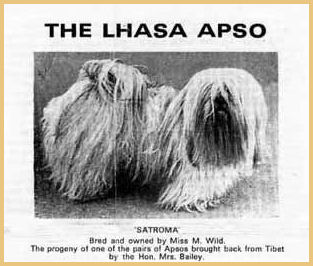
Satroma-a
progeny of one of the Lhasa Apsos brought back
from Tibet
In England
- At the beginning of the century and on
the return of the Youngsband expedition,
the first Tibetan dogs made their
appearance. At that time they were known
as ' LhasaTerriers '
Confronted with the impossibility of
bringing in new blood, breeders resorted
to English dogs (most likely to
Skye-Terriers)
Very soon, the Tibetan type was lost, and
in 1928 the Kennel Club entrusted the
direction of the breed to Colonel and Mrs
Bailey who were returning from Tibet.
Indeed, the Baileys had just brought home
from Tibet a few fine specimens of the
small variety of Apso. These had been
brought up exclusively in the jealous
keeping of distinguished families.
In 1934, together with Lady Freda
Valentine and certain other enlightened
fanciers, the Baileys established a
standard for the breed, basing also on
the description given by Mr Lionel Jacobs
in 1902.
The Second World War interrupted the
English breeding.
After the war, the English imported a few
dogs from India and amongst them 'Jigmey
Tarkey of Rungit'
of sherpa Tensing's kennel who gave the
famous 'Gunga
Din of Verles'
produced by Mrs Harding which was the
first post war champion of the breed. |
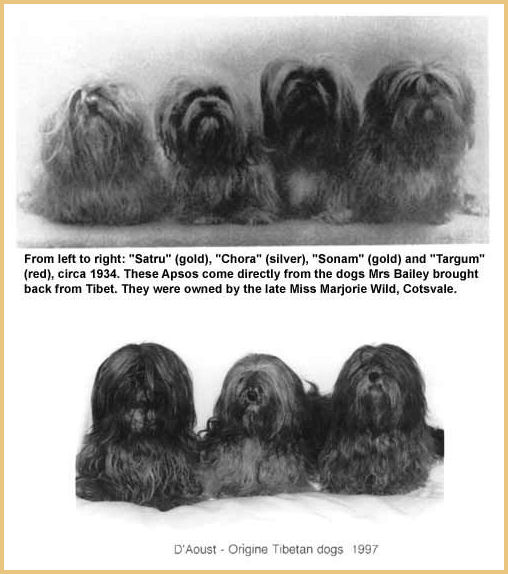
Bailey´s dogs
1934 and the D'Aoust dogs-original type 1997
In the
U.S.A - During his visit to Lhasa in
1934, Suydam Cutting, received five dogs
from the 13th Dalai Lama. This allowed
him to create his famous Hamilton Farm
Kennel in New Jersey.
In 1937 he returned to Lhasa with his
wife. As the 13th Dalai Lama had died
just before their arrival, the Regent
offered them a couple of golden
Lhasa-Apsos together with a letter which
specified :
" I am
sending you two dogs by way of Kalimpong.
Please take great care when you receive
them.
- Dated 7th of the 1st Tibetan month of
thee Water-Bird year "
I fear that
this sentence, both so simple and so full
of meaning was read only at the first
degree.
It may be that we failed to understand
the spiritual message attached to those
Apsos.
" Take great care of them " was
not alluding solely to the material
aspect.
Indeed, this dog is in the likeness of a
country where spiritual primes over
material, where nature fashions beings in
accordance with the surroundings, where
men but animals also are saturated with
spirituality which confers on them an
aristocratic bearing and expression which
no longer exist in present day Lhasas. |

Hamilton
Kangmar and Puppies 1950
In order
to increase their livestock, the Cuttings
imported two dogs from China; they were
probably Shi Tzus.
In 1940, seven English Shi-Tzus were
imported into the U.S.A. and once again
registered as Lhasa-Apsos by the American
Kennel Club. Since then, no importation
of a dog of purely Tibetan origin has
been authorized by the A.K.C.
Therefore the American issues cannot
pretend to purely Tibetan ascendants.
In Germany - In 1931 and 1939, Dr
Schäfer visited Tibet . From his second
journey he brought back some twenty dogs,
including some Lhasa Apsos, Terriers,
Mastiffs etc ... which he handed over to
the Cologne zoo. At the end of the war,
they were taken to an unknown destination
by American soldiers.
In France - In the fifties, Miss Violette
Dupont created her famous Annapurna
kennels with Hamilton Kangmar and Xeres,
male of authentic origin. |
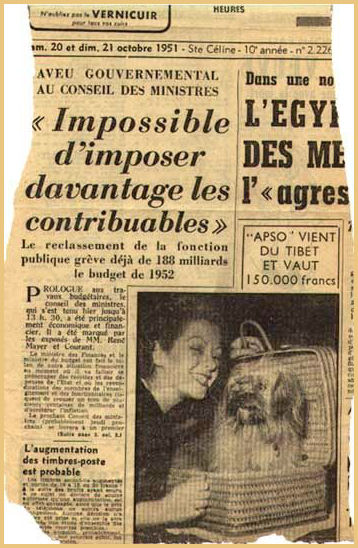
Xeres in a
newspaper clip 1951
The other
European countries followed suit.
The breed met with enormous success in
the United States. Cutting made numerous
adepts, amongst the first ones were :
-Mme Marie Stillman, affix 'Americal'
-Mme Grace Licos, affix 'Licos'
-Mme Dorothy Cohen, affix 'Karma'
The American breeders were the only ones
able to continue producing during the
Second World War which had interrupted
the development of Lhasa breeding in
England.
They strived for a strict maintainance of
the type according to the official
English standard of 1934.
When his wife died, Mr Cutting sold his
kennel to Mrs Cohen who was entirely
devoted to producing first rate subjects.
At the end of the seventies, some time
before she died, Mrs Cohen realized that
the breed could not be restocked because,
after the Chinese invasion, Tibet, had
become inaccessible. She therefore
declared : "
If you are lucky you can have a fasimile
of Karma but there never would be another
Karma."
Whilst Lhasa breeding continued to
prosper in the U.S.A. shows began playing
an ever increasing role. In order to make
sure of victory, handlers and groomers
staked on the spectacular and in the end
imposed to the judges a dog whose
morphology and characteristics where ever
more distant from the original type.
All this, considerably influenced the
breeders, who thus directed their
production towards this new type of dog.
This led to the fabrication of a
competition dog, a kind of a super-dog,
like the super-men, who nowadays reign
over sports grounds and the Tour de
France road, or like the Music-Hall super
stars.
The Lhasa is not a dog who really
appreciates rings, but certain craftly
alliances and more or less disreputable
methods, have brought about the desired
results : An arrogant gait, a haughty
neck, a large size so as to be more
present on the ring and ever longer fur
etc.. All such elements which little by
little turned the dog into a star, a
champion of the ring.
Authenticity was abandoned for the
benefit of the spectacular.
This type of dog was in the fashion and
was in demand on every side. So it
happened that the American breeders
became the suppliers of the entire world. |
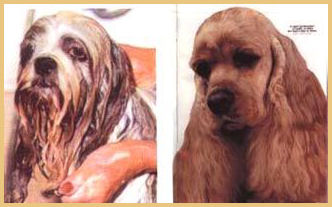
Actual present
day Lhasa vs Cocker head
IN THE
MIDDLE OF NOWHERE - as the English are so
right in saying
RESULT - Though this may come as a
surprise to some of you, the Lhasa Apso
is no longer in the fashion. The ever
dicreasing number of subjects presented
at the exhibitions, the drops in births
and the lower number of applications, all
verify this fact.
In U.S.A. where the dog's progress was
tremendous, more than 22,000 Lhasa Apsos
were registered in 1977, the second after
the Poodle in the Non Sporting Group Now
the breed ranks 23rd with 6.800
registrations per year. ( Ref. - A.K.C. )
In the
course of the last years, births
registered =
1995 1996 1997 1998
------ ------ ------- -------
in France 1255 1197 1099 1036 ( Ref. -
S.C.C. )
in Germany 183 159 138 94 ( Ref. - V.D.H.
)
The same phenomenon can be observed in
Switzerland, Holland and Belgium.
This announced crossing of the desert
cannot but be beneficial because it will
allow to correct this excess committed
during the last twenty years or so.
For the true Lhasa lovers, this is not a
bad thing, quite on the contrary.
This situation obliges us to think things
over. May be this was not quite the way
to follow for an asiatic breed, several
centuries old, which had been bred and
maintained according to different
criteria.
|
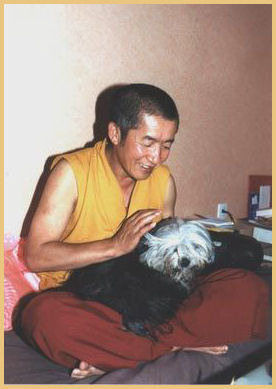
Rimpoche and
Tchang Po
The Lhasa
Apso is no longer fashionable and will
become less and less so, for as long as
the Show-Dog is considered as the model
of the breed, who can want to make a pet
of a dog with such a fur, sweeping the
pavements like a broom, a dog which has
to be washed every three days, who has to
be kept in a cage or fenced in a lawn for
the most fortunate ones, or kept in paper
curls or plaits, all for the sake of that
blessed fur. In short a cripple it is
hard to imagine.
Even the breeders end by clipping the
hair of the dogs they are not showing; So
why all this outrageous seeking for a fur
akin to hypertrichosis, often brought
about by products as dangerous as
arsenic, strychnine and others?
Such violence against nature as stupid as
it is dangerous for the dog, and so in
the end to arrive at the new fashion of
cutting its hair?
This, no doubt is the modern vision of
the third millennium Lhasa.
All such manipulations are bound to
affect the dog's behaviour. Here again,
we can find an explanation to the
agressive character which can very often
be observed in today's Lhasa, a dog with
character, of course, but not a bad
tempered dog.
God always
forgives
Man, sometimes
Nature never
And where does cynology comes in?
It has been overwhelmed by the spectacle.
All of us, breeders, judges and fanciers,
we have all been impressed by the style
and presentation of these sacred show
monsters. The standard has strangely been
forgotten for the benefit of glamour and
to the prejudice of type and size (though
this was specified in the standard : 10
to 11 inches for the males, females being
smaller) Most of the
latter years champions did not comply
with the standard.
|
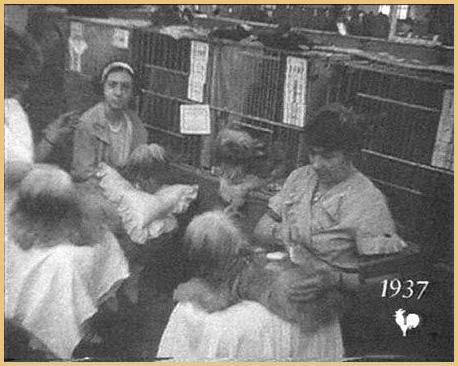
Original dogs at
Canine Expo, Paris 1937
Who is to
blame ?
For a large part the judges and show
organizers.
Why? Because the latter, owing to
budgetary constraint require polyvalent
judges who judge several breeds. So we
have to watch the heart-breaking
spectacle of the judge, who often does
not even speak the language of the
country, judging without interruption the
entire ninth group, without devoting even
one minute to each dog and needless to
say, without giving any mark,
appreciation or motive for his
judgements. (personal experience in a
foreign country I.B. )
What does cynology gain from all this?
How many breeders no longer present their
dog to such a judge because he does not
like the type of their Lhasa? What does
this mean? The judges ought to be
entirely for the breed and should show no
preference for one type or another
(large, small etc..) whereas there is
only one type,
the Tibetan type according to the
standard.
A good knowledge of the history of the
breed guarantees the respect of the
standard without taking fashion into
account. The 1934 first official standard
stipulated : 'In judging these dogs,
breed characteristics are of paramount
importance'
The presence on the ring of a poster
depicting the standard of the breed would
act as a reminder to the judge and would
enable breeders and spectators to a
better understanding of the judgment. |
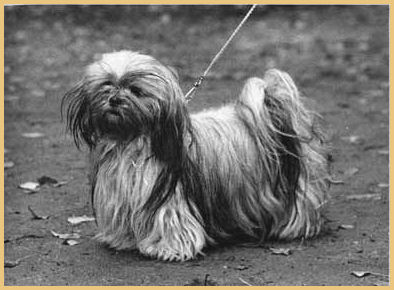
Gothama-Annapurna;
Beautiful original Lhasa type
According to
Professor Queinnec the improvement of a
breed rests on three factors :
1 - A good knowledge of the breed by the
breeders
2 - Technical knowledge given by the
scientists
3 - The judge's collaboration to reach
this end.
On the eve of the year 2 000 the question
arises : What should be done? Which way
should be taken?
As for myself, I can only see three
possibilities:
1 - Start all over again with authentic
Lhasa Apsos, rare but still existing
particularly in Canada and Bhutan.
2 - With the existing stock, resume
selection in accordance with the
standard, the aim in view being the
original type.
3 - Regenerate the present stock by
bringing in some real Lhasa Apsos. |

Waiting for
promenade (walk)- 3 original type Lhasa Apsos
This third
solution seems to be the most reasonable
one, but then; it implies the help of all
the official bodies for the registration
of these dogs with the purpose of saving
the breed.
An important German breeder has already
begun the work of returning to the
origine, basing on those two sources
still available. Let us wish her success
and may she be followed and encouraged in
her efforts by every real fancier of the
breed.
Following my previous articles, many
judges, fanciers and dog-lovers
throughout the world, contacted me to
uphold my fight and tell me how much they
shared my views. Therefore I know that I
am not alone and this encourages me to
pick up my pilgrim's stick to enter the
new millennium, hoping; always hoping. |
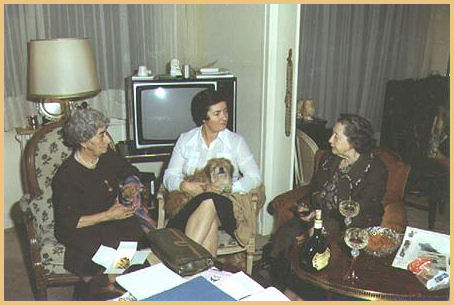
Mlle duPont,
Yolande de Zarobe and Lady Freda Valentine,
breed pioneers, discuss the future of the Lhasa
Apso
Yolande de ZAROBE
|